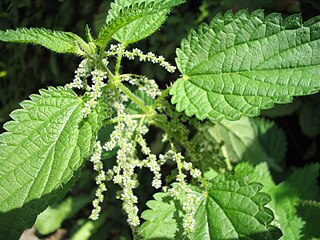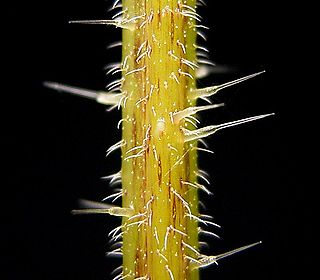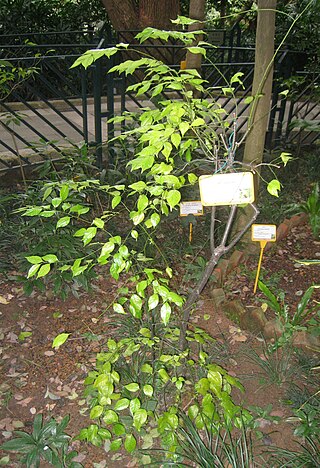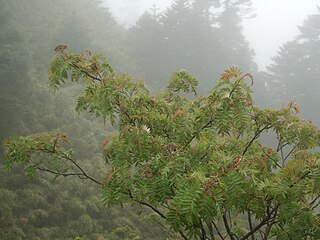
The small tortoiseshell is a colourful Eurasian butterfly in the family Nymphalidae. Adults feed on nectar and may hibernate over winter; in warmer climates they may have two broods in a season. While the dorsal surface of the wings is vividly marked, the ventral surface is drab, providing camouflage. Eggs are laid on the common nettle, on which the larvae feed.

The Urticaceae are a family, the nettle family, of flowering plants. The family name comes from the genus Urtica. The Urticaceae include a number of well-known and useful plants, including nettles in the genus Urtica, ramie, māmaki, and ajlai.

Urtica dioica, often known as common nettle, burn nettle, stinging nettle or nettle leaf, or just a nettle or stinger, is a herbaceous perennial flowering plant in the family Urticaceae. Originally native to Europe, much of temperate Asia and western North Africa, it is now found worldwide. The species is divided into six subspecies, five of which have many hollow stinging hairs called trichomes on the leaves and stems, which act like hypodermic needles, injecting histamine and other chemicals that produce a stinging sensation upon contact.

Urtica is a genus of flowering plants in the family Urticaceae. Many species have stinging hairs and may be called nettles or stinging nettles. The generic name Urtica derives from the Latin for 'sting'.

Lamium (dead-nettles) is a genus of about 30 species of flowering plants in the family Lamiaceae, of which it is the type genus. They are all herbaceous plants native to Europe, Asia, and northern Africa, but several have become very successful weeds of crop fields and are now widely naturalised across much of the temperate world.

Urtica ferox, commonly known as tree nettle and, in Māori, ongaonga, taraonga, taraongaonga, оr okaoka, is a species of nettle endemic to New Zealand. Unlike the other species in the genus Urtica found in New Zealand, all of which are herbaceous, ongaonga is a large woody shrub that can grow to a height of 3 m (9.8 ft), with the base of the stem reaching 12 cm (4.7 in) in thickness. It has large spines that can result in a painful sting that lasts several days.

Urtica urens, commonly known as annual nettle, dwarf nettle, small nettle, dog nettle, or burning nettle, is a herbaceous annual flowering plant species in the nettle family Urticaceae. It is native to Eurasia, including the Himalayan regions of Kalimpong, Darjeeling and Sikkim in India and can be found in North America, New Zealand and South Africa as an introduced species. It is reputed to sting more strongly than common nettle.

Urtica incisa, commonly called scrub nettle, stinging nettle, and tall nettle, is an upright perennial herb native to streams and rainforest of eastern and southern Australia, from the north–east southwards through the east, of Queensland and New South Wales, then across the south, through Victoria, Tasmania, south-eastern South Australia and parts of southern Western Australia. The species is also widespread in the North and South Island of New Zealand.

Anthophila fabriciana, also known as the common nettle-tap, is a moth of the family Choreutidae first described in 1767 by Carl Linnaeus. The moth can be found flying around stinging nettles during the day.

Sphagneticola calendulacea is a perennial herb in the genus Sphagneticola. It is found in China, India, Indonesia, Japan, Myanmar, Philippines, Sri Lanka, Thailand, Taiwan and Vietnam. Tolerant to drought, humidity and barren environment, S. calendulacea is a common herbaceous plant in China and Taiwan. S. calendulacea produces wedelolactone and demethylwedelolactone.

Dendrocnide meyeniana or the poisonous wood nettle is a species of tree in the family Urticaceae, native to the thickets and secondary forests of Taiwan and the Philippines. The specific epithet meyeniana honors Franz Meyen, who collected the type specimen in Manila during his world cruise.
Urtica massaica is a species of flowering plant in the Urticaceae known by many English names, including Maasai stinging nettle and forest nettle. It is native to Africa, where it can be found in Congo, Burundi, Rwanda, Kenya, Uganda, and Tanzania.

A stinging plant or a plant with stinging hairs is a plant with hairs (trichomes) on its leaves or stems that are capable of injecting substances that cause pain or irritation.

Urtica gracilis, commonly known as the slender nettle, tall nettle, or American stinging nettle, is a perennial plant plant without woody stems that is well known for the unpleasant stinging hairs on its leaves and stems. It is native to much of the North America from Guatemala northwards and temperate areas of South America. It is easily confused with the visually very similar Eurasian species Urtica dioica and is still listed in some resources as a subspecies of this plant. However, genetic analysis and experiments show that they are genetically distinct.

Urtica pilulifera, also known as the Roman nettle, is a herbaceous annual flowering plant in the family Urticaceae.

Ilex asprella, also known as rough-leaved holly and plum-leaved holly, is a deciduous shrub native in South East Asia. Ilex asprella is one of the few deciduous species in the family Aquifoliaceae.

Hibiscus taiwanensis, or the Taiwan cotton rose, is a native plant in Taiwan, which lives in China and low altitude in Taiwan. It is a species of plant in the Malvaceae family. The form of flower is different from Hibiscus mutabilis in China, which is double. It can attract butterflies.

Sorbus randaiensis is a species of deciduous tree in the family Rosaceae. It is endemic to the mountain areas of central Taiwan, with altitude 1,800m to 3,200m, mostly spotted in the forest of Xueshan, Hehuan Mountain, Mount Xiluan, and Nenggao Mountain. It is a tree 3–8 m tall with white flowers and reddish fruit.
Urtica fissa is an upright perennial herb native to streams and rainforest of China.
Piper kawakamii, also known as the Kawakamii pepper, is a flowering plant in the family Piperaceae. It is a native endemic species in Taiwan. The plant is mainly distributed in the Hengchun Peninsula. It was collected by Takiya Kawakami at the Kuraru Community, on July 2, 1906. In 1911, the plant was published by Bunzō Hayata as a new species. The type specimen of this plant is being preserved in the Botanical Gardens, Graduate School of Science, the University of Tokyo, Japan.and the Herbarium of Taiwan Forest Research Institute


















